
‘The term ‘post-internet art’ has emerged in recent years to acknowledge the profound impact hyper-connectedness, abundance of information and collective conversation has on our lives, subjectivities and art. It groups together artistic practices clearly influenced by the proliferation of the internet into everyday life. Although it is a contested term, little-loved by many artists associated with it, and a confusing one (at first suggesting art created after the end of the internet, rather than that ushered in by the arrival of web 2.0), it has a certain usefulness.
‘Of the many artists associated with post-internet art who are ‘digital natives’, Ryan Trecartin (born 1981, United States) is one of the most lauded. The narratives and editing of his moving-image works – which he refers to as ‘movies’, in defiance of the widely adopted terms ‘videos’ or ‘films’ – question traditional film and television programs and the ways such material is consumed and navigated by a generation raised with the internet, multiple screens and communication devices ever present. This is achieved in part by the aesthetic character of Trecartin’s movies, which often employ cacophony as a guiding and structural principle: the acting, editing, sound and sets are constantly in excess and operate at a high-pitched register echoing that of the information age. In this cacophony, digital natives see a representation of themselves and their everyday lives, while older ‘digital immigrants’ recognise the technological clamour that has come to surround them; Trecartin’s movies reflect each group’s experience to some degree.
‘Other crucial aspects of Trecartin’s practice have contributed to his recognition within this conceptual milieu. The sheer ambition of his movies is immediately striking, but never feels driven by a sense of singular achievement. There is the sense of the ensemble at work in them, in the tradition, unconsciously or not, of filmmakers such as Rainer Werner Fassbinder, Paul Morrissey (at least while working with Andy Warhol), John Waters or Pedro Almodovar. While Trecartin writes the scripts (along with acting in, filming, editing and sometimes scoring the resultant movies), his creative practice is enfolded with that of artist Lizzie Fitch. Trecartin and Fitch have been collaborating since they were first-year students of Rhode Island School of Design in 2001, when Trecartin majored in Film/Animation/Video and Fitch in Painting. They formed a production studio together in Los Angeles and see their relationship as central to the creation of Trecartin’s movies. When exhibited as video installations, these ‘sculptural theatres’ are co-credited to both artists. Filled with bland carpet of the type found in cheap office renovations, and populated by quasi-designer flat pack furniture, the sculptural theatres mimic the bland ubiquity of the movies’ environments, complete with various props that appear in or are implied by them.
‘The Re’Search Wait’S series, 2009–10, for example, is one part of the project Any Ever, a diptych comprising seven autonomous but interrelated videos. The other part, Trill-ogy Comp., consists of the three works K-CoreaINC.K (section a), Sibling Topics (section a) and P.opular S.ky (section ish), while Re’Search Wait’S comprises four movies: Ready, The Re’Search, Roamie View : History Enhancement and Temp Stop. Whereas a certain visual mashup aesthetic characterises the montage technique employed by Trecartin in this series – similar to having multiple windows open on a computer, replete with computer effects, plug-ins and animated transitions – there exists a tension between the cut-and-paste, slapdash and disordered approach this connotes and the highly considered work required to create the sets, choreograph the scenes, direct the actors and crew and produce the scripts underpinning the seven movies.
‘The performances, too, provoke this tension, at first coming across as improvised due to their manic delivery and the mix of trained and untrained actors, but quickly recognisable as highly scripted in Trecartin’s very particular, punning language: a patois of text messages, ASCII art and corporate brand sloganeering. When viewed in written form4 the text’s link to concrete poetry is clear, about which Brian Droitcour has written persuasively in the journal Rhizome. Droitcour is at pains to point out the difference between Trecartin’s generative approach and the pure appropriation of found words and phrases:
Trecartin’s writing responds to the internet, but it defies an assertion made by Kenneth Goldsmith, poet and founder of UbuWeb, who wrote that flarf and conceptual poetry are the quintessential poetic responses to the digital age because they employ cut-and-paste techniques.
‘Droitcour asserts that this approach results in poetry by Goldsmith that, while often humorous, is ‘so sterile, it’s unreadable’, and that his technique of reconstituting nonsense phrases from found linguistic scraps ‘petrifies genre and meaning with it’.
‘Sterile is one thing Trecartin’s movies are not. Rather than the unordered (or randomly reconstituted) nature of the cut-and-paste aesthetic, his work engages a multiplicity that mimics and extends the sense of the internet as being an experience of information overload and noise, with various commentaries vying for the viewer’s attention. Flame wars in internet chatrooms, long-running hoaxes on multi-authored wikis, a teenage girl’s weekly YouTube program fictionalising her home-schooled life, endless viral attempts to remake the Harlem Shake dance style and performing tweens practising virtually anything in front webcams are now all very contemporary, narcissistic and neurotic phenomena. Re’Search Wait’S presents the legacy of such present-day activity, the movies’ gossiping, sniping discourse interspersed with karaoke-like performances to form a picture resembling the confessional, or talent-spruiking, personal webcam diaries of teens in ‘real life’ (with the intensity of a hyperactive child off their Ritalin).
‘Trecartin’s plotlines are not so much convoluted as they are polyphonic and fragmentary, embodying the nature of the internet itself. There can be multiple viewpoints, text and stock footage vying together on screen at the same time, cutting in and out in different rhythms. Characters’ voices from different scenes talk in unison, or in staccato counterpoint, at different speeds and pitches. Dramatically, we often do not see cause, only effect. When first encountering the movies, the plot can be difficult to grasp for these reasons, but they reward immersion and multiple viewing. Most of Trecartin’s movies are available on the internet, which allows them to be grazed by viewers in their own time, and the works’ spacious, immersive installation in the gallery offers a chance for non-contiguous viewing; the physical act of moving from one to the other acting as a form of editing. Rather than diminishing the experience of the work, dipping in and out of it in a non-linear way merely reaffirms its structural logic at odds with the traditional linear cinema experience.’ — Simon Maidment
____
Stills

















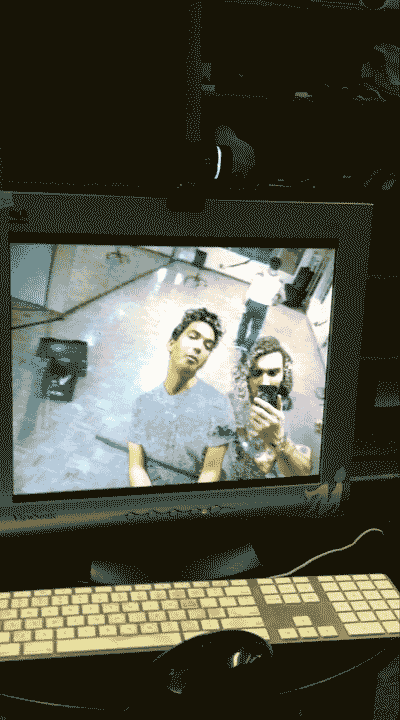








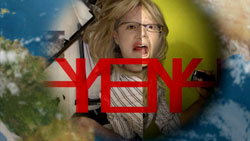






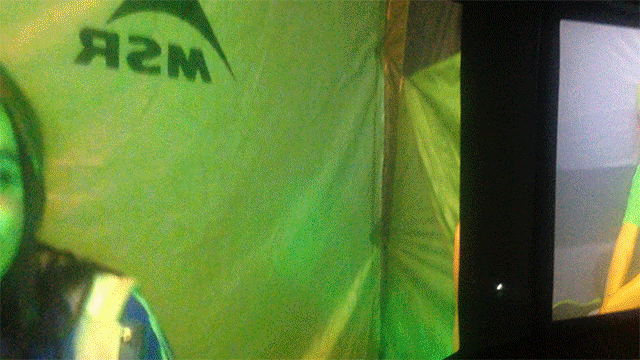







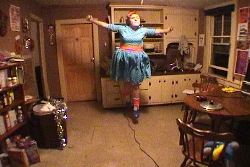


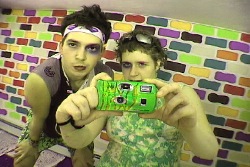







___
Further
Ryan Trecartin @ Vimeo
Ryan Trecartin @ Andrea Rosen Gallery
Ryan Trecartin @ Regen Projects
Ryan Trecartin @ instagram
Portrait of Ryan Trecartin
‘It’s Exciting to Be in a Swing State’: Why Artists Ryan Trecartin and Lizzie Fitch Moved to Ohio to Build a Rural Amusement Park
How Artists Ryan Trecartin and Lizzie Fitch Built a 32-Acre Queer Playground in Middle America
Neighborhood Watch: Lizzie Fitch and Ryan Trecartin
ROT THE MAP
Ryan’s Web 1.0
Lizzie Fitch and Ryan Trecartin’s B-horror version of America’s rural fantasy
RYAN TRECARTIN: THE REAL INTERNET IS INSIDE YOU
McMansion of media excess: Ryan Trecartin’s and Lizzie Fitch’s SITE VISIT
Ryan Trecartin – Metaphorical Puke
The Automedial Zaniness of Ryan Trecartin
Ryan Trecartin & Lizzie Fitch STAGE the 2.0 society
Decoding the Cinematic Cyberworld of Ryan Trecartin
Ryan Trecartin’s Night Vision Sweatshirt
Experimental People
Past and Future Camera: Lizzie Fitch and Ryan Trecartin’s New Movies
‘Sound Design Is Sort of Everything’: Ryan Trecartin on Making Music, Live and Otherwise
Exploding the Frame: Ryan Trecartin’s Bad Language
Meet Ryan Trecartin, Art’s First Genius Of The YouTube Age
On Ryan Trecartin
“We Had Our First Red Bulls Together”: Lizzie Fitch and Ryan Trecartin on Their Dusk-Till-Dawn Collaborative Process
Ghost of the future past: on the work of Ryan Trecartin
____
Extras
Ryan Trecartin Interview: The Safe Space of Movies
Lizzie Fitch / Ryan Trecartin: Whether Line / Fondazione Prada Milano
Lizzie Fitch/Ryan Trecartin – Behind the scenes
Ryan Trecartin in conversation with Hans Ulrich Obrist
Ryan Trecartin Interview: Gender is Fluid
______
Interview
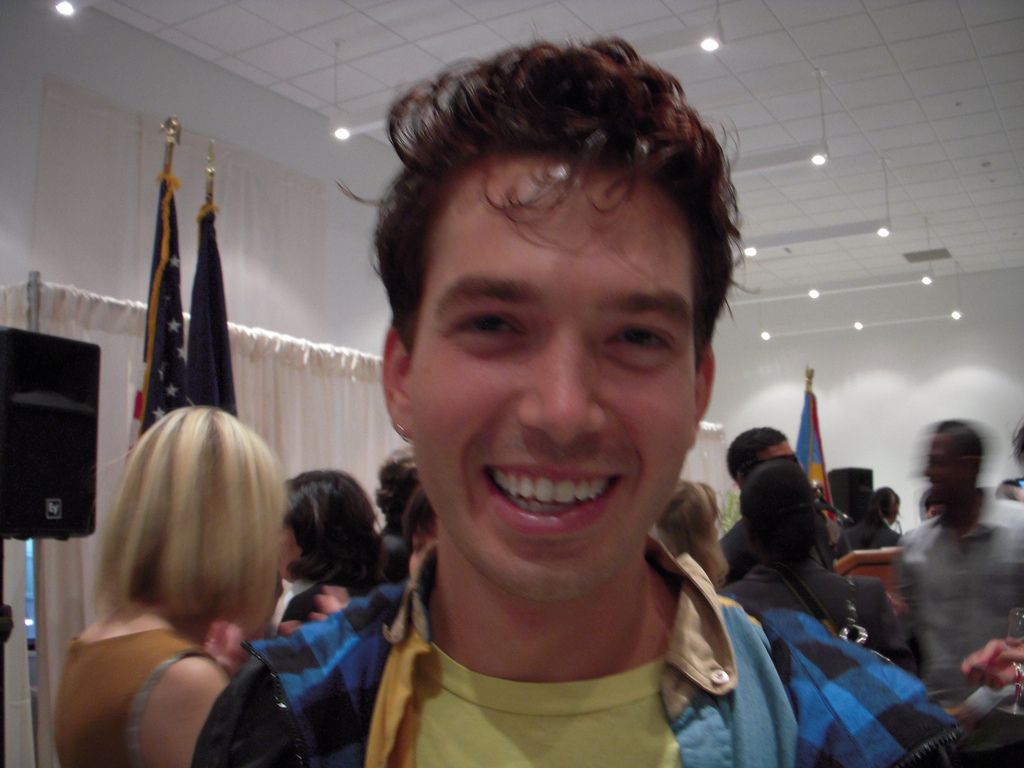
Sarah Lehrer-Graiwer: Last time we talked, in early 2013 or something, you were in the middle of editing a new piece, as you are now. It’s a strange time to talk about the work because so much happens in editing. And about a minute ago you were telling me how, this past year, you moved studios and your home.
Ryan Trecartin: Yeah, we did a ton of moving. We moved our house to Burbank, and then we moved our Burbank studio to Glassell Park. We originally rented our last house to double as a studio, but for the Venice Biennale project, we needed a studio to create those particular sets. We ended up liking having a studio in which we could build sculptures and different things that don’t work in a domestic setting. We go in and out of wanting a separate studio space. Right now we want one, but I can feel us already going back to wanting a house and getting rid of the studio. (laughter) Moving’s fun.
SLG: Moving’s fun? Who says that? (laughter) Moving’s the worst.
RT: I was getting depressed about the fact that I lived in that Los Feliz house for five years. Even growing up, I’ve never lived in a house longer than that. I don’t like making projects in the same places.
SLG: Like a new place is inspiring and exciting for ideas, even if it’s just an empty warehouse?
RT: Yeah, even if there’s nothing culturally different about it. It can be architecture that changes and that’s it. We’ve been talking about moving to a different city again.
SLG: This makes me think of your interest in people born in the mid–’80s and their relationship to media. Now that generation is growing up. Maybe it’s not yet happening in your circle, but these past couple years, a lot of friends are having babies, you know?
So I wonder, Can ways of living stay the same? Do you want them to? This settling down, employing people, having a staff—is it part of getting older and your interest in the generational?
RT: Well, I’m not really interested in things staying the same.
SLG: Even if your mode is constant change.
RT: It doesn’t yet feel like settling down, but if it did, I might not like it. We’re not interested in the same things as before—I say we meaning a lot of different things, but right now I’m talking about Lizzie and me primarily. When it comes to youth, I’ve always enjoyed it as a topic or a mode, and not necessarily as an age-related thing. It’s more about the relationship to self and culture, and negotiations of freedom.
Although I do think about when people were born in sort of an algorithmic way. It’s interesting that people born at different moments in time have different relationships to ideas. It doesn’t mean everyone in that age group has the same relationship—there’s the general flow and then the margins.
SLG: Youth as an attitude or a relationship to freedoms or self-formation makes sense. This is a side note, but I want to say that reimmersing myself in your work reminds me just how much it affects me on the level of permissiveness and what’s possible. It’s amazingly generative.
RT: K-Hole, who were in the Triennial, wrote something on the youth mode that’s like what you’re describing.
SLG: You’ve busied yourself with looking at a wide range of practices and artists, having co-curated the Triennial. I would imagine that is very different from being in the studio. What was that process like?
RT: I’m still digesting the experience. Working with Lauren was amazing. She traveled a lot, and did so many studio visits. Then she would present them all and we would talk about them. She really allowed me to continue being an artist. I got to glean all this amazing research and have a huge say in it, which was incredible. And that opportunity came at a moment when the artists we were researching were not that far from me generationally. But my mind is far from that right now …
SLG: If it’s too far away, we’ll move on.
RT: I think it’s important not to be too focused on past work when you’re creating new work, so I have purposely been trying to forget stuff temporarily. Like, I practice forgetting things, and then I have to try to remember them again later.
SLG: How does that work?
RT: Something’s a thought-loop, so I picture it and then I remove it.
SLG: Can you do that all in your head? Or do you keep a notebook?
RT: I do, but I don’t go back and read my notes much.
SLG: At least once you get an idea down, then you can let yourself forget, because it’s down somewhere.
RT: I mean, I love remembering, too—but sometimes you have to forget in order to grow. Or something will reemerge because you pushed it away, and it comes back in a different form. That’s a big part of the way we make movies. Things that we thought were over sneak back in a different form, even just words and phrases.
______________
13 of Ryan Trecartin’s 23 videos
______________
Valentines Day Girl 2001
‘Trecartin crafts a fantastical narrative about a girl whose obsessive personal utopia is disrupted. Trecartin’s collaborator, Lizzie Fitch, plays a girl obsessed with Valentine’s Day. Everything in her hyperactive, sped-up world revolves around Valentine’s Day: red, white, and pink love-themed decorations cover every surface; heart shapes abound; Valentine’s Day treats are everywhere. Her private festivities suddenly go awry as a hoard of Christmas-themed intruders appear and take her hostage in her own apartment. Gagged and bound, she is forced to watch while her ecstatic but sinister captors stage a frenzied Christmas intervention.’ — Electronic Arts Intermix
the entirety
______________
Wayne’s World (2003)
‘Trecartin and his collaborator/co-star Lizzie Fitch ponder the messages delivered by the most banal forms of mass media and pop culture in their own unique version of a music video. They voice questions in song and dance segments that feature a deliberately ill-fitting pastiche of discarded fashions of the past two decades and recycled pop-music clichés. Totally immersed in their meticulously crafted private universe, Trecartin and Fitch coyly point at the gaudy artifice surrounding us in our own.’ — Electronic Arts Intermix
Excerpt
______________
What’s The Love Making Babies For (2003)
‘In What’s the Love Making Babies For Trecartin employs digital manipulations, extreme editing, and chaotic dialogue in a way that is characteristic of his artistic style, creating a world that is “hyper-saturated with media.” More relevant to the concerns of this program, he also engages with ideas of authority, expertise, and the dissemination of information, as his characters forward their often warped and sometimes indecipherable ideas surrounding “reproduction, sexuality, and contemporary moralities” by engaging with traditional formats such as the TV commercial. However, Trecartin roots his movie in the digitized Internet landscape, thus evoking questions surrounding how modes of communication and information transmission transform and morph in the digital age.’ — Calvin Tomkins
the entirety
_______________
A Family Finds Entertainment (2004)
‘If A Family Finds Entertainment can be reduced to a thumbnail description, this might be it: Trecartin stars as Skippy, a clownish but terrifyingly psychopathic boy who has locked himself in the upstairs bathroom of his family home during a wild party. Ignoring his siblings’ and friends’ pleas that he come out, he paces the little room, cutting himself with a knife and musing opaquely on his existential dilemma in a kind of King Lear-style delirium. Downstairs, the partiers are experiencing wild mood-swings and having complex, disassociated conversations (mostly about him) that are constantly interrupted by bursts of visual effects and animated sequences that disorient the cast of characters like so many lightening strikes. Eventually Skippy emerges, borrows money from his creepy, sexually inappropriate parents, and heads outdoors, where he runs into a documentary filmmaker who decides to make a movie about him; but then Skippy is immediately hit by a car and, apparently, killed. Back inside the house, a hyperactive girl named Shin, also played by Trecartin, gets a call on her cell phone with the bad news. She spends twenty or so hysteria-filled minutes trying to focus and construct a sentence linear enough to tell her friends what has happened. When she finally does, a band plays music that seems to magically raise the young man from the dead, and everyone runs outside and sets off fireworks. Then everyone runs back inside before the police show up. A wonder of Trecartin’s videos is that his approach seems as intuitive and driven by a mad scientist-style tunnel vision as it is rigorous and sophisticated, grounded in his expert editing and inordinate gift for constructing complex avant-garde narratives.’ — Dennis Cooper, Artforum
the entirety
_______________
(Tommy Chat Just E-mailed Me.) (2006)
‘Trecartin describes (Tommy Chat Just E-mailed Me.) as a “narrative video short that takes place inside and outside of an e-mail.” Trecartin’s intense visualization of electronic communication is inhabited by a cast of stylized characters: Pam, a lesbian librarian with a screaming baby in an ultra-modern hotel room; Tammy and Beth, who live in an apartment filled with installation art; and Tommy, who is seen in a secluded lake house in the woods. Pam, Tommy and Tammy are all played by Trecartin, who, wearing his signature make-up, jumps back and forth between male and female roles.’ — Electronic Arts Intermix
the entirety
______________
I-Be Area (2007)
‘The videos of Ryan Trecartin catapult viewers into a hallucinogenic alternate reality in which cybernetic avatars run amok, presenting themselves with gleeful sass as they play out a complex web of melodramatic fictions. I-Be Area (2007), a feature-length promenade through this universe, was written, directed, and edited by Trecartin, who also stars in no fewer than five roles alongside a troupe of friends and collaborators. The work’s elusive narrative, which revolves around the clone I-Be II and such cohorts as Jamie, RAmada Omar, and ONxy-Tonyah, is filtered through a distinctive do-it-yourself aesthetic that incorporates ramshackle sets, brightly colored homemade costumes, cheap off-the-shelf video and sound effects, and rapidly edited, jargon-filled dialogue. Through these means Trecartin creates a striking new vision of queer culture in America, wittily updating the carnivalesque style of avant-garde filmmakers like Jack Smith and Kenneth Anger for the era of YouTube and Second Life. Unlike Smith and Anger, however, Trecartin draws his audiences further into his virtual reality through sculptural objects and installations built from his sets, including Jamie’s Bedroom (2007), which is in the collection of the Guggenheim Museum. Over time, it becomes apparent how thin the line separating Trecartin’s world from our own truly is.’ — Nat Trotman
the entirety
_______________
Trill-ogy Comp (2009)
‘Trill-ogy Comp consists of three movies: K-CoreaINC.K (section a), Sibling Topics (section a), and P.opular S.ky (section ish). The title of this piece of the Any Ever diptych riffs on the words “trill”—as in the rapid alternation of two notes, or the sound produced by rolling “r”s—and “comp”— as in “complement,” “comprehension,” and, especially in regard to music and digital editing, “composition.” Each movie follows the structuralist unity of form and content, self-reflexively building and demonstrating formal logic through narrative abstractions.’ — MoCA
K-CoreaINC.K (section a)
Sibling Topics (section a)
P.OPULAR S.KY (section ish)
________________
Re’Search Wait’S (2010)
‘Through their form as well as their content, the Re’Search Wait’S movies directly engage some of the most noted effects of the internet and social media on our lives and ways of being: the changing relationship between the individual and the collective; the global advancement of corporate brand consolidation (at the expense of diversity); rampant commodification; and the fluidity of identity. The manner in which Trecartin, with his collaborators, has fused these in the Re’Search Wait’S series as a future projection of the information age marks it as a post-internet artwork par excellence, being ‘about’, ‘of’, and ‘meta-’ these effects (and affects) simultaneously. In it we encounter the mutated embodiment of tomorrow’s promise, today.’ — Simon Maidment
Ready
The Re’Search
Roamie View : History Enhancement
Temp Stop
________________
CENTER JENNY (2013)
‘CENTER JENNY is one of four movies completed in 2013 by Ryan Trecartin, first shown as part of an installation at the Arsenale during the 55th Venice Biennale. For this movie and its related works, Lizzie Fitch and Trecartin created a modular maze of sets on a soundstage with the help of commercial set builders. Designing with Google’s open source 3D modeling programSketchUP, the artists along with these tradespeople built a functional system of environments. The space is rigged to radically adapt for different purposes, but shifting as a narrative one as well, guiding action much in the way that a written script does. No pun intended, the set in its various manifestations is a central feature of CENTER JENNY, where Trecartin fixates on notions of location and proximity but continually eschews any concrete grasp of them.
‘The cast ranges from collaborators familiar from previous works dating as far back as to A Family Finds Entertainment (2004) to professional actors from popular television sitcoms. Most belong to one of several groups of uniformed girls who are all named Jenny. One duo of Jennys wears earmuffs and pink hoodies branded “AUDITION;” another posse dons khaki shorts and tank tops covering up greenscreen-green bikinis; other, grittier girls are in sweats that read “W4$T3;” a more womanly group in neutral tones identify themselves as nameless proto-Jennys, held in limbo as they await matriculation into “The University.”
‘The various Jennys belong to a caste system in which iterations of the same, basic, archetypal girl differentiate themselves from one another based on how powerfully they have evolved. The notion of being “basic”, in fact, is a flattening condemnation the girls hurl back and forth at one another. There is a quantitative basis for self-actualization here, and, as if in a video game or any other kind of entertainment simulation, a level-based logic propels the Jennys as they graduate from nothing – “I don’t have a name yet, we’re not even on a level” – to level one, to level two, and beyond. This guides the plot as well, which shifts abruptly from one vignette to the next in an arc that escalates without concern for scenes that have been surpassed by more evolved ones.’ — Kevin McGarry
the entirety
_______________
Comma Boat (2013)
‘In Comma Boat, we’re stuck in a mock-authoritarian fantasy–a power trip. The film centers around a director-character played by Trecartin who oscillates between feelings of omnipotence and self-doubt. As if a post-human, post-gendered reincarnation of the Fellini character in 8 ½, the director gloats and frets about professional and ethical transgressions. “I know I lied to get ahead,” he admits at one point. “I’ve made up so many different alphabets just to get ahead in my field.” The director is fancier now, but the fear nags that he might be “repeating” himself “like a dumb soldier ova and ova and ova and ova.” The meta-connection to the artist’s own career, while obvious, is also a decoy. All art, at some level, is about the artist. Here, reflexivity is the surface level, providing a decodable veneer that encases something more unsettling and complex.’ — Electronic Arts Intermix
the entirety
______________
Item Falls (2013)
‘In Item Falls, we are peaking. We start out at a casting call, but before long we’re firmly in the grip of hallucination, shedding our anxieties and evidently regressing to the animation era, a time when stunt chickens were mere chicklets. Friendly archetypes float in and out of what seems like our bedroom. The red-headed Jenny has returned, but this time she’s squeaky and trusting. Unlike in Center Jenny, here our perspective is literally centered. The camera seems to be the in middle of the room, which is good, because we’re too blissed out to move. Luckily, our hallucinations look directly at us.’ — EAI
the entirety
______________
Mark Trade (2016)
‘Distraction, of course, remains the mise en scène. In a time when millions of videos on the Internet vie for users’ attention, I get the feeling that Fitch and Trecartin’s characters would much rather be checking their phones than doing anything else—including appearing in a Fitch and Trecartin video. In Mark Trade (2016), the titular protagonist, a drunken and off-putting man with long hair and oddly colored contacts, says, “This used to be a lake, but I can’t get any fucking service anywhere now.” The artists’ faithfulness to the Internet’s hysterical diversion renders the characters mysteriously underdeveloped.’ — Alex Greenberger
the entirety
______________
placebo pets (2016)
‘Every autumn, W Magazine dedicates one cover story to the world of contemporary art. The resulting imagery never falters in its ability to cause commotion, as the periodical succeeds in uniting the worlds of high-fashion, celebrity and art into one. Past covers have seen Angelina Jolie photographed by then-beau Brad Pitt and Linda Evangelista through the lens of Maurizio Cattelan. This year, W Magazine does it again, with Kendall Jenner and Gigi Hadid – arguably two of fashion’s most buzz-worthy figures – gracing the magazine for its 10th anniversary art issue. Working alongside video artists Lizzie Fitch and Ryan Trecartin, the supermodels have been transformed into human-animal hybrids through heavy digital altering. Entitled “Placebo Pets”, the editorial creates an alternate reality that asks us: “Who would survive if a superior alien humanoid species came to earth?” Dressed in the latest trends by Philipp Plein and Hood by Air, the royal heiresses of reality television each tackle the role of a post-gender, post-biracial being. The visuals are reminiscent of Snapchat’s ubiquitous face-altering filters, with Jenner’s features exaggerated to create a bunny-cat and Hadid’s amplified to morph her into a lion-fox. New identities in tow, both women live in an imaginary future created by Fitch and Trecartin. This new universe is not far from the one we inhabit now, with the creative duo hoping to offer a critical eye into our present-day human behaviour.’ — SLEEK
the entirety
*
p.s. Hey. ** David Ehrenstein, Hi. I don’t like ‘Gerry’, so that’s fine. Re. IR: and in lit in general! I don’t know who Charles Reich is, and the NYTimes won’t let me in. I’ll figure him out. ** Sypha, Hi. Yeah, it was definitely easier for me to hit the desert than for you there in R.I. Are there any deserts west of the Rockies? I don’t think so. They still making trading cards as tie-in merch for TV shows and stuff? Wow, that’s surprising (to me) and really kind of sweet. ** Steve Erickson, Yes, I have read about his new play, and that could have the semi-conscious impetus to make that post. I wonder how bad the print is on that ‘FNoaD’ stream. I saw a good but still rough print at the Cinematheque here last year that is supposed to be the very best one available. But the version on the bootleg Dvd you can buy of ‘FNoaD’ looks just terrible. ** Keatony, Dude, your voice could be a calling card. Critics could parse it for secret nuances and stuff. Heavy and great that you’re recording it and its basis. I thought The Beast got torn down. Could easily be wrong. Maybe it was Son of The Beast that torn down. My favourites are X-2 at Magic Mountain and Taron at Phantasialand. That joke has a lovely confusing undertow. ** _Black_Acrylic, It’s fantastic. ** Paul Curran, Hey, Paul! Mmmm, acid in the desert. One of physiology plus nature’s greatest offsprings. Me too, in other words. I think there’s some Gisele thing happening in Tokyo at some not so future point, but I can’t remember. I never get to go on tour with the pieces. I’m the first expenditure that gets cut from the squad. But Zac and I are determined to get there. We’d hoped to already be there, but all these projects are cementing us here. But soon. We literally start daydreaming up a trip every time we see each other, which is often. Good, good, great that the j-novel is still occupying you and inching forwards! Ever (more) excited for that. Mine … I’m just waiting and waiting for a break from other stuff to dig heavily back into it. Soon, I think. I’ve read through what I’ve got a number of times, and it needs a ton of work, but I think there’s enough there to warrant going ahead. I know just a little about the Setagaya murders, but I haven’t looked into it for quite a while. I remember they only knew a few things, like the sweater the killer wore and that he was not of pure Japanese descent? You live near that house? It looks so idyllic and rural in the photos I’ve seen. Are you researching them for a project? ** Corey Heiferman, Cool. “Mumbo Jumbo’ is great. His novel ‘The Freelance Pallbearer’ is also really great. Ha, interesting trajectory from America to Trump. Huh. I just remember them as being kind of a sub-Eagles badly imitating Neil Young thing. What a horrible song. Lord. ** Bill, Hi. Ah, you read ‘MJ’, awesome. Is that Frameline you’re talking about? This guy I’m FB friends with is relentlessly promoting some film or event at that festival by or about him called ‘The Mayor of Castro Street’? That’s the only thing I know that’s playing there. The French distributors of ‘PGL’ are just re-releasing this gay film from the 80s called ‘Together Alone’ that I vaguely remember and which looks kind of interesting, so I’ll see that. ** Okay. Today I devote the blog to one of my very, very favorite visual artists and very, very favorite video/filmmakers, Ryan Trecartin, who I personally think is kind of a total genius. You have an opportunity to start checking out his work and initially seeing what you think. So why not do that. I’ll see you tomorrow.




 Now available in North America
Now available in North America 
Yes I agree RT is a genius. Back in 2009 I reviewed his I-Be Area with a gang of female artist friends at the Tramway in Glasgow, and it can be found at Yuck ‘n Yum here.
Tricartin is correct about the experiences of people born at different times. I feel this more keenly as I grow older. His work is remindful of Carmelo Bene and The Cockettes (especially Hibiscus)
I’m suprirsed you don’t like “Gerry.” It’s my cat’s favorite movie.
This Sunday Wheeler Winston Dixon an old Filmmaker’s Coop campadre who I have seen in 60 years will be appearing with a selection of his films at the American Cinematheque in Los Angeles.
Dennis, re: trading cards, yeah, they still do. I don’t know if I ever told you this, but my younger brothers are obsessive basketball card collectors. I’m not like that at all, but if there’s a movie or a TV show I like sometimes I’ll get a box of the trading cards. For the last few years now (since 2013) I’ve been taking boxes of Game of Thrones cards to open up while vacationing in Maine, but because this year the set for the new season hasn’t been released yet, I needed something else, so I decided to do Stranger Things.
More than half done Shiel’s PRINCE ZALESKI. Published in 1895, it’s an odd book, I guess you could say it’s kind of a Decadent Sherlock Holmes affair (though the titular character has more in common with Poe’s Dupin than Holmes). The main character is a listless, hashish-smoking, turban-wearing, possibly homosexual reclusive eccentric who lives in a semi-ruined abbey decorated with bizarre objets d’art (including an actual mummy!) and who solves the crimes brought to him without even raising from his divan. Imagine if Huysmans’ Des Essientes had been a sleuth-for-hire and you will get some idea of the nature of the book’s contents. It’s not a literary classic by any means but it’s still stylistic fun…
Trecartin has been a big name in the art world for years now, but I’ve never seen any of his movies until today. I’ve only had time to watch TEMP STOP & COMMA BOAT, but he captures the feeling of Internet-induced ADHD very well, especially in his use of superimpositions and split screens. The characters remind me of the way teenage YouTubers so often feel like they’re trying on personae in a way that comes across as DIY reality TV, except that their posturing has real power over their friends and fans. Beyond drag, COMMA BOAT flirts with implications of blackface. Without heading to Google, I can guess there has been a great deal written about that aspect of Trecartin’s work.
Hey Dennis,
it’s been a minute. how have you been?
so glad to see Trecartin day on here, such a fantastic voice right now, unique and kind of terrifying all in one. (best combo). do you a favorite of his films?
finally finished with school and got a new job with some solid pay for once.
finally gonna be getting a copy of PGL soon, so excited!
always along c
haha, RT is what happens to my brain when I smoke weed. Reminds me of Cindi Sherman and Matthew Barney. haha, no comment. it’s pretty bad, but I’m working on it. I will explore the coasters, my nephews here, well probably be going to theme parks. trying to get a song on the track today. starting to miss Paris. its hot as a mug in FL. went out to check out the Pride crowd last night, saw almost everybody I hate lol.
Latest FaBlog:Alexandria Again and Forever
Thanks for this RT stuff. I love GIF work – yours and the whole image macro explosion from 7-8 years ago. I don’t do much anymore but here’s a link to a bunch of stuff I did awhile back – enjoy – https://www.behance.net/gallery/56651069/IMAGE-MACRO-GIF-ONE
I tried explaining ‘Gerry’ to a bunch of people at work recently and they looked at me like I’d been dropped on my head.
It’s the weekend – thought you might enjoy this as well – https://www.mixcloud.com/SJXSJC/xerox-over-manhattan-megamix/
I always try and make a mixtape to my newest novel – kinda like a soundtrack etcetc
Good to drop in today. Your post makes me think of my years as a projectionist, I remember RT being the nicest guy. For that matter, so is GVS, who was _exquisitely_ chill when, during a screening of (incidentally) “Gerry,” the film split and had to be spliced and rewound mid-show, by me. Projector malfunctions are not good for any movies but this one it really kinda wrecks the mood.